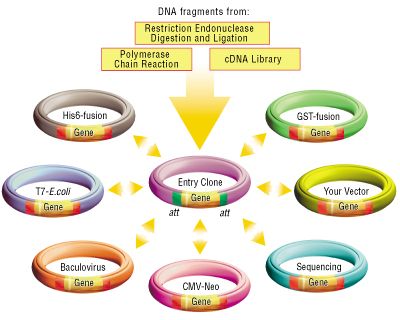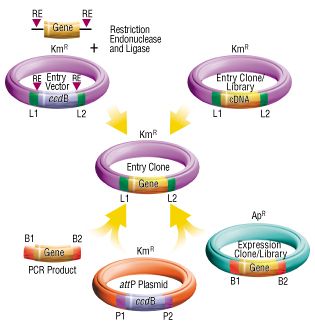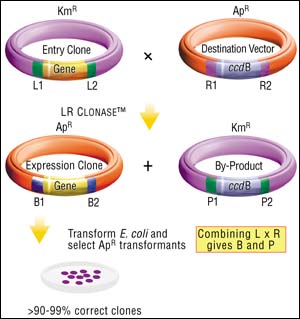This web page was produced as an assignment for an undergraduate course at Davidson College.
What is Gateway Cloning Tecnology?
Cloning Technology is becoming increasingly important in the field of biology, particularly genetics and molecular biology. The cloning itself, like other methods, allows for functinoal analysis of genes, protein expression, and cloning or subcloning of DNA fragments. Gateway cloning, however, provides an extremely fast and efficient route to those ends. To achieve this new and novel line of cloning, your gene of interest enters the "Gateway" and is then available for all your cloning needs. The ease of the Gateway method is provided by the att recombination sites used in combination with enzyme clonase mixes.

Figure 1. Overview of the Gateway method. At
the top your gene of interest is inserted into the Gatway system via an entry clone. The
three yellow boxes represent possible sources of your gene of interest. Once the entry
clone has been formed it is available to express your gene in a variety of other vectors.
Not only that, but as is indicated by the yellow arrow, the vectors may in turn form new
entry clones. This ease is provided by the att recombination sites used with enzyme
clonase mixes.
Why is Gateway Cloning Technology better?
Gateway improves upon other cloning methods such as the use of restriction enzymes and PCR's in several ways. Foremostly, Gateway is extremely rapid, no overnight incubations are necessary. The Gateway system incubates for a single hour before it needs to be tranferred to a medium. It is easy to get your gene of interest expressed into vector systems due to the Gateway recombination sites. The method is extremely effiecient, typically in the upper 90% range. This efficiency is due to the ccdB gene preventing the growth of phages in medium, as well as the two types of antibiotic mediums used. Finally, the Gateway cloning method in totally universal. That is, all types of DNA fragments may be cloned, whether that be PCR fragments, cDNA, or genomic DNA. Gateway is also available for several organisms, from mammals and insects to E. coli.
How does it work?
The first step to Gateway cloning is inserting your gene of interest into the Gateway. That is, inserting your gene in an entry clone. An entry clone is a plasmid containing your gene of interest and flanked by Gateway attL recombination sites. There are four ways to obtain this clone. The first is the standard restriction enzymes and ligases. However, the entry vector used in this clone will be a Gateway vector with the attL sites in it. The second way is to create a PCR product with terminal attB sties, using primers containing a 25-base pair attB sequence, plus four terminal G's. This product will then be inserted in the entry clone using the BP method to be discussed later. The other two possiblities for forming an entry clone are entry clone with a cDNA library, or an expression clone containing your gene of interest.

Figure 2. The four possiblities of creating an
entry clone. Clockwise from upper left: restriction enzymes and ligases used with gene of
interest, cDNA library, expression clone, and PCR product.
Now that the entry clone is made things actually become easier! That is because with this lambda phage you may clone your DNA, using an LR reation, or make new entry clones from previous cloned vectors using the BP reaction.
But you may be wondering what these L's and R's, B's and P's stand for. The are the key component of the gateway system. They are the restriction sites abreviated from attX, where X is your L, R, B, or P. All entry clones have attL's on both sides of their gene of interest. These are necessary in the Gateway system because these L's are cut to form sticky ends by the Gateway recombination proteins. These sticky ends will then match up with the sticky ends on a destination vector which contains attR restriction sites. This simple process is called a LR reaction. It is how the expression clone is formed. From these expression clones we will make our protein, analyses, etc.

Figure 3. LR reaction. Entry clone with attL
recombines with a destination vector with attR to form a new expression clone with attB
and a byproduct with attP.
The expression clone which is formed actually contains segments of the L and R restriction sites, but the new site which is formed is called a B site in the expression clone, and a P site in the by product. These are important because the Gateway system is totally reversable, that is we can make more entry vectors from this expression clone in a BP reaction. It works essentially the same way except that when B sites recombine with P's they form L's and R's.
These reactions are quite simple to conduct. An LR reaction involves your entry clone, a destination vector, and the LR clonase mix. This mix contains the recombination proteins necessary for excision and incision. All you do with this mix, is incubate it for an hour and you are done. The BP reaction is exactly the same except with different vectors and a slightly different recombination proteins.
Figure 4. Overview of the cloning recombination process. Requires Macromedia Shockwave Flash.
With the expression clones made the process is almost complete. All that needs to be done is tranform the clone into E. coli cells and place them on medium. Here again the Gateway method makes things easy by giving an extremely high yield of correct clone on the medium. This is because the vectors used in the recombination process include antibiotic resistance and a clever gene call ccdB.
You will notice in figure three that both the byproduct and any leftover destination vector contains the ccdB gene. What this gene effectively does is prevent cells from growing on culture, even if they have the resistance to the antibiotic. Also, the cells that are grown contain antibiotic resistance, ampicillin for the LR reaction, and kainmiacin for the BP reaction. This also prevents leftover entry clone and byproduct from growing.
So what's left?
Your gene fully expressed and ready for analysis, or using again.
All information on Gateway Cloning Technology was obtained
on it innovator's, Life Technologies, web
page.
"Life Technologies introduces revolutionary GibcoBRL Gateway
Cloning Technology." <http://www.lifetech.com/gateway>
Accessed 20 February 2000.
Author: Aaron J.
Patton
Return to the
International House of Aaron
Return to Aaron's Molecular Biology Switchboard
Return to Davidson's
Molecular Biology Homepage
(c)2000